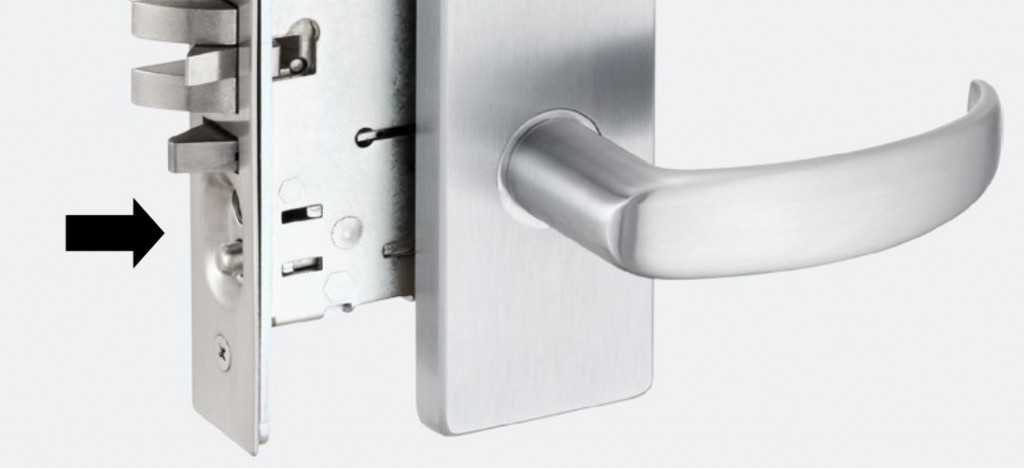This question has come up a few times lately, so I’ll ask for your input even though it’s pretty far into the nitty-gritty. Some mortise lock functions use buttons or a toggle on the door edge to lock or unlock the outside lever. They’re not as common any more, but some facilities have a strong preference for this type of lockset. Here’s a description of how the function works:
- Latch bolt operated by knob/lever from either side except when outside knob/lever is made inoperative by buttons in face. When outside knob/lever is locked, latch bolt is retracted by key from outside or by operating inside knob/lever. Auxiliary dead latch. Outside knob/lever is unlocked by button on face. [LG: In this case, “face” means the lock face which is on the edge of the door.]
You can exit by turning the lever on the inside or enter by using a key in the outside cylinder, but in order to change the outside lever from locked to unlocked (or vice versa), you need to use the buttons on the edge of the door. There are different styles among the different lock manufacturers – on some locks it is a toggle switch, others use 2 buttons.
Here’s the question…does this type of lock meet the accessibility requirements? It doesn’t require tight grasping, pinching, or twisting of the wrist, but the buttons require a fair amount of control and probably can’t be operated by someone without a hand. This is one of several applications that may meet the technical requirements of the accessibility standards, but in reality are difficult to operate by people with certain types of disabilities. Have any of you had experience with AHJs allowing or not allowing this function?
WWYD?
You need to login or register to bookmark/favorite this content.








I have an opinion, and I’ve written specifications for private (i.e., non-public funding) projects rejecting edge-operated stopworks. Reading through the code, it’s silent regarding this specifically, but I believe we can discern accessible-design intent by looking to the requirements for elevator accessibility and call button sizing.
Ultimately, rather than futz with code language, the industry should go to accessibility advocacy groups and see if edgeworks pose a barrier. If so, then amend the code and give mfrs some time to redesign.
Does the code require the locking mechanism to be without tight grasping, pinching, or twisting of the wrist? The unlatching and operation of the door is still without tight grasping, pinching, or twisting of the wrist!
I was thinking along the same lines. It was my understanding that unlatching and operating the door must be accessible at all times, but the intricacies of locking/unlocking would need to be only modified as needed. Also, it would seem that any ‘storeroom’ or ‘night latch’ function lock would never be considered accessible because of the need to turn a key while also pulling the door open. How is that any different than this toggle switch?
For example, all tables and desks do not need to be accessible at all times, but if an employee needed modification because of accessibility issues, then the employer is required to make the modification. I brought this up in regards to a bathroom design within a private office suite a while back. The response I received was that accessibility wasn’t required unless the employee using that office needed it and then a modification would be required.
Right.. if you can’t use the toggle, odds are you aren’t able to use a key either. I don’t know that accessibility requirements apply.
Keys are not covered by the ADA because they aren’t a permanently-attached part of the lock. I know it doesn’t really make sense, but they are exempt.
– Lori
The ADA requires handles, pulls, latches, locks, and other operable parts on doors and gates to be operable with no tight grasping/pinching/twisting, so many AHJs are interpreting that to mean that all parts and functions of the lock must meet this requirement.
– Lori
So whats about a cylinder? does it also have to be accessible and easy to turn? I understand that the key is not a part of the lock but the cylinder is!
I guess the cylinder is not considered to have operable parts.
– Lori
At our university we’ve changed our standard for office function locks. They must be controlled by a thumbturn, and an oversized thumbturn at that.
We’ve reduced or eliminated all of our lock bodies with toggle on our shelf used for repairs in favor of replacing the lock and adding the ADA friendly thumbturn.
How far is this going to go. What about the key operation. Even with a large head key blank, you still have the twisting action to unlock a door. Maybe ALL door operations / functions should be wireless!!??
Not a part of the ADA discussion but I’ve run in the problem that the end user didn’t know the “buttons” were even there on the side of door. The advantage of a thumb turn is that it is right there above the handle – totally visible.
The boss or the boss’s appointed person should set the functions on these locks, and then they should be left alone. The reason I’ve never been a big fan of them is unauthorized persons sometimes change the way the lock works without permission, and even authorized persons often get confused. In all but rare instances, the user needn’t fumble around with the edge controls. If the function needs to be changed, again, the authorized person should be the one to do it. I avoid them tot he extant that I can.
HUSHHHH We have never had a disability complaint with any of these but I guess it is coming. We have many of these in buildings that go back more than 90 years. There are several types and different ways they work. Most of the models can have the “status” changed by pushing the edge mechanism with the tip of a key. If a person can’t use a key then they may not be able to open the door anyway.
We have had to change a small number of doors to “classroom” function (usually cylindrical models) to accommodate people who could not turn the key hard enough to retract the latch but could unlock the outer lever and then get in.
I don’t think the toggle comes into play any more than the key operation of the locking cylinder. The basic use and operation of the lockset meets ADA requirements, but to be safe, use the office function that has turn-piece locking (rather than a toggle) and be sure to use the larger ADA type turn-piece available from most manufacturers. That should do the trick if you have a really picky inspector.
Locking or unlocking the outside knob/lever has no relationship whatever upon exit from the interior, the inside knob/lever always unlocks the door in a single motion, thus I don’t see any accessibility issues. We do not recommend the ANSI F04: office function, nor for that matter any mortise lock with stop work buttons. We prefer the F13: dormitory function which prevents lock-outs and forces the occupant to throw the deadbolt to lock the door from the interior via thumb piece or exterior with the key. ADA turnpiece required on the interior. My two cents.
Since i am a security guy, I am not real fond of this lock function. Rather than replace the lockset, can the scalp plate be replaced with a standard office function plate that does not provide access to the buttons… instant store room function!
That’s a good question. I’ll bet someone knows the answer.
– Lori
My college dormitories (back in the 70’s) had locks with these (perhaps originally installed in the 20’s).
It took us a long time to figure out why sometimes the door would stay unlocked after one used a key, and other times it would be locked the next time you tried to get in.
The latter usually happened when returning from the bathroom, keyless.
Of course that’s when it would happen! Like the time I left my hotel room in my pjs to go to the vending machine, and the door guard sprung across the door when I closed it and I couldn’t get back in – even with my card!
– Lori
i am of the opinion that they meet the intent of the code, i also believe that the intent is to allow egress always and entrance during business hours, and not necessarily to change from locked to unlock, to be pro active i would try eliminate when replacement allows. Just my opinion
Funny thing about intent when it comes to legislation. Who really knows later and does it matter?
I am in Canada and so ADA does not apply. However, when I see the use of ‘intent’, I suddenly realized it meant something different to me than given above by Richard Wright. To me, handicapped accessibility legislation is about giving reasonably equal access to all. The intent is the big picture and the details of code should follow from that. And when I think of this, I consider the public coming into some building but also the people working in it. It is easy to say we will change it following a complaint but is that really ‘best practice’ when you can see somebody with mobility impairment could enter that place any day or be hired any day.
So I ask, why not develop accessability to do all tasks the hardware can do for the current users and not say this function is important enough to think and change but that is not. It is parallel to saying this person is worth considering and that person is not. All too easy for a business to not hire somebody in a wheelchair since the washroom can not accomodate it or it would be too expensive now to change it. See, we do not need them since this place has no staff which need it. It is a bad agruement and most people know it.
On the toggle itself, I dislike them from a security point of view. People both lock themselves out and other times leave the door unlocked but closed thinking it is locked. If you must have them, I like the idea of asking people with disabilities if this works. In big institutional places, we are talking the same coin for an office function with toggles as a classroom. If a mortice, an internal thumbturn is a good idea.
I had not realized the big head on some keys we had seen was not required by ADA. The big Medeco and Schlage may not be workable for all disabled but certainly better than those little Abloy Protec. Still, for some key insertion and extraction will be the issue. Of course, not getting a 100% solution is NEVER an arguement for not doing a 50% solution.
Well, my 3 cents Canadian,
Martin
I’ve seen a lot of these on older doors. If you notice the buttons are recessed, even on the old stuff, so you can put a blank plate that covers the buttons. They are for most part a user option that even if the door is locked when exiting the door unlocks or allows egress with use of the handle or lever.
No one has mentioned the big problem with these lock buttons for ALL users-: There is NO indication when exiting that you will be LOCKED OUT.
Where can you jet a blank plate to cover the buttons?
Baldwin for example.